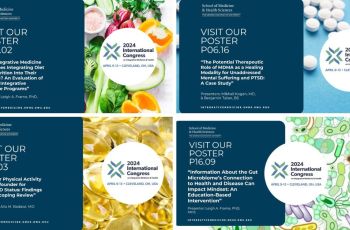The Dietary Guidelines for Americans Process
Phase 1
Dietary Guidelines Advisory Committee
- 20 nutrition experts
- With public comments
- Develops the Scientific Report, which was released in July of 2020
Phase 2
HHS & USDA use the Scientific Report to update the Dietary Guidelines through a 3 step process that includes review by Federal and external expert.
Phase 3
Once the new Dietary Guidelines are released, HHS releases resources for health professionals to share with patients, such fact Sheets and other resources will be released in 2021.
What’s New in this Process
The 2020-25 Dietary Guidelines were released on 12/29/2020. These are the first Dietary Guidelines developed through the updated process using the 5 principles identified by the National Academies “to improve the integrity of the process to develop credible and trustworthy guidelines”:
- Enhance transparency
- Promote diversity of expertise and experience
- Support a deliberative process
- Manage biases and conflicts of interest
- Adopt state-of-the-art processes and methods
This process requires that HHS & USDA “provide the public with a clear explanation when the Dietary Guidelines for Americans omit or accept only parts of conclusions from the scientific report”
What Stands out for 2020-2025
“For two topics – added sugars and alcoholic beverages – the Dietary Guidelines includes part, but not all, of the Committee’s advice.”
“The Dietary Guidelines emphasizes the importance of limiting intakes of added sugars and alcoholic beverages, but does not include the changes to quantitative limits recommended by the Committee. However, there was not a preponderance of evidence in the Committee’s review of studies since the 2015-2020 edition to substantiate changes to the quantitative limits for either added sugars or alcohol. Thus, the 2020-2025 edition underscores the importance of limiting added sugars and alcohol intake, and retains the quantitative limits from the 2015-2020 edition. USDA and HHS encourage more research on the relationship between added sugars and alcoholic beverages and health, and will continue to monitor the evidence on these topics.”
From the Dietary Guidelines for Americans
1st Update
- Historically focused on healthy individuals
- Now “more than half of adults have one or more diet-related chronic disease”
- “A fundamental premise of the 2020-2025 Dietary Guidelines is that just about everyone, no matter their health status, can benefit from shifting food and beverage choices to better support healthy dietary patterns.”
2nd Update
- New focus on dietary patterns
- We do not eat nutrients, we eat foods, which are complex matrices of nutrients and non-nutritive bioactive components
- Then how these foods are consumed over time is really the crux of the issue—that is a dietary pattern
- These “foods and beverages act synergistically to affect health”
- “It’s about the pattern of eating, not just healthy choices here and there.”
3rd Update
- New lifespan approach
- “identifying needs specific to each life stage and considering healthy dietary pattern characteristics that should be carried forward into the next stage of life”
- “For the first time since the 1985 edition, the 2020-2025 Dietary Guidelines includes recommendations for healthy dietary patterns for infants and toddlers.”
4 Overarching Guidelines
- “Follow a healthy dietary pattern at every life stage……it is never too early or too late to eat healthfully”
- “Customize and enjoy nutrient-dense food and beverage choices to reflect personal preferences, cultural traditions, and budgetary considerations”
- “The Dietary Guidelines framework purposely provides recommendations by food groups and subgroups—not specific foods and beverages—to avoid being prescriptive.”
- “ensures that people can “make it their own” by selecting healthy foods, beverages, meals, and snacks specific to their needs and preferences.”
- “Focus on meeting food group needs with nutrient-dense foods and beverages, and stay within calorie limits”
- “Make Every Bite Count” call to action
- “Most of the calories a person eats each day (~85%) are needed for foods rich in nutrients that help the person meet food group recommendations.”
- “Only a small amount of calories (~15%) are left over for added sugars, saturated fat, and, (if consumed) alcohol.”
- “Limit foods and beverages higher in added sugars, saturated fat, and sodium, and limit alcoholic beverages.”
4 Specific Guidelines
- “Limiting added sugars* to less than 10% of calories per day for ages 2 and older and to avoid added sugars for infants and toddlers;”
- The Committee recommended limiting added sugars to less than 6% based on updated food pattern modeling with the caveat that “individual diets may be able to accommodate higher or lower intakes of added sugars depending on other dietary choices made”
- Besides previous science, the 10% is based on those with caloric requirements are greater than 3,000 calories per day. While 2,000 – 2,800 is around 7%; 2,000 calories being the basis for the Nutrition Facts Label.
- “Most Americans have less than 8 percent of calories available for added sugars”
- While there appears to be no clear agreement in these numbers, 10% does seem high based on the Committee’s models and analysis by HHS & USDA.
- “Limiting saturated fat to less than 10% of calories per day starting at age 2;”
- “Limiting sodium intake to less than 2,300mg per day (or even less if younger than 14);”
- “Limiting alcoholic beverages* (if consumed) to 2 drinks or less a day for men and 1 drink or less a day for women.”
- The Committee recommended that the Dietary Guidelines:
- Advise adults “not begin to drink alcohol or purposefully continue to drink because [they] think it will make [them] healthier,” add clarity that the limits apply to “days when alcohol is consumed,” and state that “drinking less is generally better for health than drinking more” at all levels of consumption.
What was included?
Advice that individuals not start drinking and that drinking less is better for health than drinking more. Further, clarity was added by stating that limits are “in a day, on days when alcohol is consumed.” - “For those who drink alcohol, recommended limits are up to 1 drink per day for both women and men."
Why wasn’t this included?
The emerging evidence related to cancer and cardiovascular disease does not reflect the preponderance of evidence at this time, but rather the 2 drink limit for men. More research is needed.
- Advise adults “not begin to drink alcohol or purposefully continue to drink because [they] think it will make [them] healthier,” add clarity that the limits apply to “days when alcohol is consumed,” and state that “drinking less is generally better for health than drinking more” at all levels of consumption.
- The Committee recommended that the Dietary Guidelines:
3 Key Dietary Principles
- “Meet nutritional needs primarily from foods and beverages.”
- “Choose a variety of options from each food group.”
- “Pay attention to portion size.”
Most Americans do not follow the Dietary Guidelines
- “The average American diet scores a 59 out of 100 on the Healthy Eating Index (HEI), which measures how closely a diet aligns with the Dietary Guidelines.
- Research shows that higher HEI scores can improve Americans health.”
Sources & Resources:



